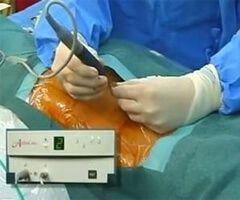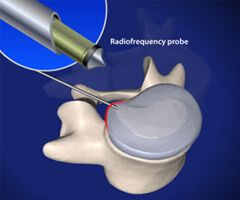Percutaneous Disc Nucleoplasty Surgery in India
What is the meaning of Percutaneous Disc Nucleoplasty Surgery?
 Intervertebral discs are cushion-like structures located between the bones that make up the spine. Under certain conditions, these discs can bulge and cause back pain. Percutaneous Disc Nucleoplasty is a minimally invasive procedure to reduce the pressure inside a disc to relieve pain. Because no incision is made, the recovery time is shorter than traditional open surgery methods. Intervertebral discs are cushions between the vertebrae that form the spine. The discs are the shock absorbers between the bones, providing stability and easing movement. Nucleoplasty treats pain caused due to herniated discs. An experienced radiologist removes a small portion of disc the tissue using image guidance, to relieve pressure on the nerves. The treatment can alleviate pain and restore mobility. Nucleoplasty is a minimally invasive procedure, which makes smaller incision, has fewer risks of complication, and takes lesser recovery time as compared to traditional surgery. The innovative imaging technology plays a key role in planning and performing each procedure, and on-staff physicists and engineers ensure that the machines are upgraded eventually.
Intervertebral discs are cushion-like structures located between the bones that make up the spine. Under certain conditions, these discs can bulge and cause back pain. Percutaneous Disc Nucleoplasty is a minimally invasive procedure to reduce the pressure inside a disc to relieve pain. Because no incision is made, the recovery time is shorter than traditional open surgery methods. Intervertebral discs are cushions between the vertebrae that form the spine. The discs are the shock absorbers between the bones, providing stability and easing movement. Nucleoplasty treats pain caused due to herniated discs. An experienced radiologist removes a small portion of disc the tissue using image guidance, to relieve pressure on the nerves. The treatment can alleviate pain and restore mobility. Nucleoplasty is a minimally invasive procedure, which makes smaller incision, has fewer risks of complication, and takes lesser recovery time as compared to traditional surgery. The innovative imaging technology plays a key role in planning and performing each procedure, and on-staff physicists and engineers ensure that the machines are upgraded eventually.
Percutaneous Disc Nucleoplasty is a minimally invasive procedure wherein the doctor utilizes a small needle and advanced radiofrequency technology to reduce the herniated disc. This procedure quickly frees most patients from pain and discomfort. The procedure is generally performed on an outpatient basis using a gentle, relaxing medicine and local anesthetic. The technique is as follows :
- Cannula insertion
- Treating Disc Nucleus
After the doctor injects some anesthetic to numb the area where the incision is to be made, he inserts a thin needle known as a cannula through the back and into the herniated disc. He uses an X-ray imaging technique to guide the placement of the cannula.
A small radiofrequency probe is inserted into the disc through the cannula. The device sends pulses of radio waves to dissolve small portions of disc nucleus. Since the doctor removes enough disc material to reduce the pressure inside the disc, the spine regains stablilty.

Planning your medical trip to India is a very simple process with Spine and Neuro Surgery Hospital India
- You just need to fill in our enquiry form and one of our executive will contact you soon.
- +91-9325887033 Call us at the given to contact number for any assistance.
- Complete information regarding surgery is provided on our website.
- Relieving from Herniation
- Post-surgery recovery
The hollow created enables the disc to reabsorb the herniation. The surgeon uses heat to seal the disc.
After the physician removes the treatment equipment, the insertion area is covered with a small bandage. Since no muscles or bone are cut during the procedure, recovery is fast. The patient may need a day’s bed rest after the procedure and some physical therapy, and is ready to return to normal daily activities within one to six weeks.
Causes of disc herniation
With age, discs lose water content and become narrower, less flexible, and decrease in effectivity as cushions between the vertebrae. As a disc degenerates, the outer layer weakens, bulges, or tears. A herniation occurs when the outer layer ruptures and the inner fluid starts leaking. Disc-related problems are more common among middle-aged people. Older adults are at the greatest risk for herniated discs because of decreased disc water content. Other risk factors are overweight and smoking. Keeping poor body posture when lifting or performing repetitive strenuous activities can also cause discs to bulge or rupture.
Symptoms of disc herniation
Disc problems cause neck or back pain, burning or tingling sensations, numbness, weakness, or pain. Depending on the location of the disc in the spine, the symptoms may spread to your arms or legs.
Diagnosis for disc herniation
 The doctor can diagnose a herniated disc by performing a physical examination, reviewing medical images, and conducting nerve studies. The doctor will ask about symptoms and medical history. There are many procedures to treat disc problems. Percutaneous disc nucleoplasty surgery is suitable for discs that have bulged but not ruptured.
The doctor can diagnose a herniated disc by performing a physical examination, reviewing medical images, and conducting nerve studies. The doctor will ask about symptoms and medical history. There are many procedures to treat disc problems. Percutaneous disc nucleoplasty surgery is suitable for discs that have bulged but not ruptured.
During the Percutaneous disc nucleoplasty, the patient will wear a gown and be laid lying face down. The skin in the treatment area will be sterilized and numbed with an anesthetic. The doctor will use X-ray image technique to guide a thin tube-like cannula to the bulging disc. Afterwards, a narrow radiofrequency device is inserted through the cannula. The device transmits radio waves that dissolve small areas of the nucleus pulposus. This creates room for the nucleus contents to spread, reducing pressure on the disc, thus decreasing disc bulge. When the procedure is complete, the cannula and radiofrequency devices are removed. Since a small incision is needed for the procedure, there are no stitches and the insertion point is simply covered with a small bandage.
After the surgery is done and the patient can return home, he/ she should have someone drive him home in case they have received relaxation medication. Most patients need about a day’s bed rest following a percutaneous disc nucleoplasty. Physical therapy is strictly suggested after the procedure. Recovery from percutaneous disc nucleoplasty is individualized.
Why to plan your medical tour with us?
- As the group of Specialized Spine Surgeons, we have developed strong relationship with clinic and hospital partners, which allow us to get priority service to address all requests.
- Unlike most organizations, we recommend services from top surgeons; we have received various treatments from.
- You only need to give a small good faith deposit prior to departure.
- We understand Medical Treatments can't wait, and hence our process is time bound and focused.
Want to have a FREE Consultation for your Percutaneous Disc Nucleoplasty Surgery in India?
We will give you best surgeons for taking best and safe treatments at an affordable low cost. Post a query and get a quick response
Click HereWhat are our Special Services offered to International Patients?
- Flexible and tailor made packages.
- Organizing flights and accommodation.
- Arrangement of medical visa to India. (read the news paper articles of our site to know more about it)
- Coordinating treatment and correspondence on your behalf.
- Access to leading medical institutions and doctors.
- Significant savings compared to private healthcare
- Foreign Language Interpreters
- Assistance for Foreign Exchange conversion requirements
- Assistance for getting Local Mobile SIM Card / Internet Data Card
- Follow up Care including personalized consultations with Senior Consultants via email/ Tele-Consultation after return back to home country.
How to plan your Percutaneous Disc Nucleoplasty Surgery in India with 9 Easy Steps?
You will receive our full support before, during and after your travel to India for your treatment. The medical travel process outline is given below:
- Visit our website; Send us initial Query & Medical History.
- Patient will get connected with the coordinator.
- Specialized doctors will review the medical details of the patient.
- We will be providing the clinical opinion, recommendations of top doctors and costing regarding the surgery to the patient for their convenience.
- The patient’s will be connected with the Specialized Doctors regarding their concerns.
- The patient will approve the Cost, the Surgeon and the Hospital.
- Our team will provide guidance for the visa process and accommodations to the patients.
- After the patient arrival he or she will be admitted to the Hospital and will be guided properly during and after the surgery.
- Follow ups will be taken after the patient returns to his or her Hometown.
Are you looking for affordable cost of Percutaneous Disc Nucleoplasty Surgery in Top Hospitals of India?
Please consult us to get FREE Quotes, Opinions from TOP Hospitals and BEST Surgeons of India for Percutaneous Disc Nucleoplasty Surgery.
CLICK HERE to get a “No Obligation Quote”